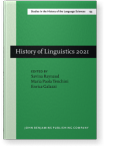Chapter 1
Can linguistics and historiography of linguistics profit from each other?
I offer support for an affirmative answer to the question in the title by means of two case
studies. The first one is on the notion of predication. I compare two recent theoretical studies, arguing that one of
them is less satisfactory than the other, since it does not consider the original Aristotelian notion of predication,
which is necessary for an adequate treatment of natural language. The second case study deals with Immediate
Constituent Analysis, which some scholars argue dates back to long before Bloomfield: this conclusion was drawn by
implicitly equating ‘constituent’ with ‘word group’, while the two concepts actually differ. Our discussion leads to
the issue of ‘paradigm’ in Kuhn’s sense: to what extent are scientific notions formulated in different epochs and
conceptual frameworks comparable? I maintain that they can be compared, by resorting to some approaches to the history
of sciences that are different from Kuhn’s.
Article outline
- 1.Introduction
- 2.Two case studies
- 3.Some possible objections to our approach
- 4.Concluding remarks
-
Acknowledgments
-
Notes
-
References
This content is being prepared for publication; it may be subject to changes.
